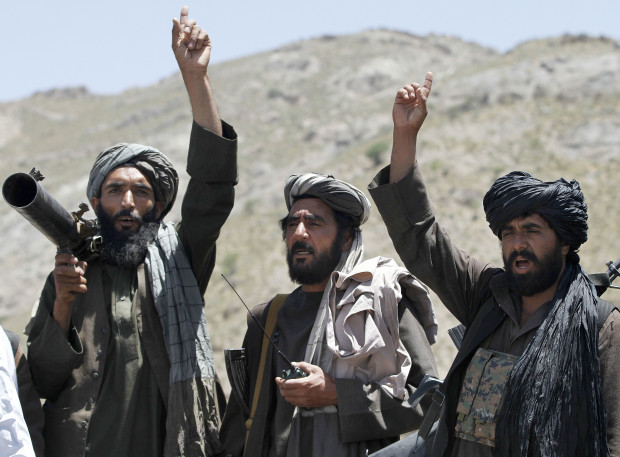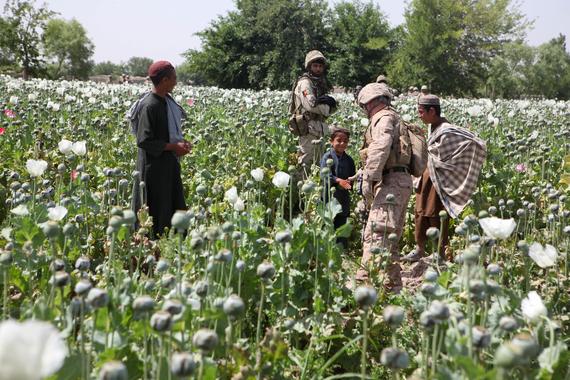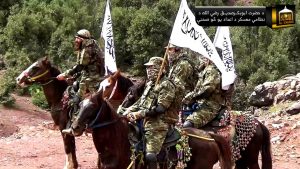Has The Taliban Won? – It Seems So

The Taliban has been quite audacious of having coerced its main 20-year-old opponent, the U.S., into signing a deal last year — Doha Agreement — that would require the complete withdrawal of U.S. troops from Afghanistan by May 1, 2021. In exchange, the Taliban agreed to stop attacking foreign forces and to sever ties with international terrorist groups, such as al-Qaeda, the Islamic State, and ISIS affiliates — eastern Afghanistan has witnessed an increase of attacks by the Islamic State group, which has declared war the country’s minority Shi’ite Hazaras.
The Islamic jihadist Taliban, or as they call themselves the Islamic Emirate of Afghanistan, has essentially won the war against the United States. This can be ascertained from its recent bellicose speech of their deputy leader, bragging of “conquests,” to scornful references to the “foreign masters” of the “illegitimate” Kabul government, to the Taliban’s own website tally of “puppets” (Afghan soldiers) killed.
The jihadists’ audacity is in part due to the fact that they have coerced their main 20-year-old American adversary into signing a deal last year — Doha Agreement — that would require the complete withdrawal of U.S. troops from Afghanistan by May 1, 2021. In exchange, the Taliban agreed to stop attacking foreign forces and to sever ties with international terrorist groups, such as al-Qaeda, the Islamic State, and ISIS affiliates — eastern Afghanistan has witnessed an increase of attacks by the Islamic State group, which has declared war the country’s minority Shi’ite Hazaras.

More than 775,000 U.S. military personnel have deployed to Afghanistan since 2001. Of those, about 2,400 died there and more than 20,500 came home wounded, according to Defense Department figures.
While the Biden administration has yet to definitively say whether it will meet that deadline, just a month away, it is fair to say that, just like his predecessors, he has yet to admit that the U.S. has been losing the Afghan War for years.
The Concealed Truth as to Why the War was Lost
As reported at the end of 2019, The Washington Post published a series titled “The Afghanistan Papers,” government officials who directly were involved in the decision making over the past two decades conceded that they had long seen the war was not winnable.
The documents also contradict a long chorus of public statements from U.S. presidents, military commanders and diplomats who assured Americans year after year that they were making progress in Afghanistan and the war was worth fighting.
In conducted interviews, more than 400 insiders offered unrestrained criticism of what went wrong in Afghanistan and how the U.S. became mired in nearly two decades of warfare.
“We were devoid of a fundamental understanding of Afghanistan — we didn’t know what we were doing,” according to Lieutenant General Douglas Lute, who served as the White House’s Afghan war czar during the Bush and Obama administrations.
“What are we trying to do here? We didn’t have the foggiest notion of what we were undertaking. lf the American people knew the magnitude of this dyfunction… 2,400 lives lost,” Lute added, blaming the deaths of U.S. military personnel on bureaucratic breakdowns among Congress, the Pentagon and the State Department. “Who will say this was in vain?
Several of those interviewed described explicit and sustained efforts by the U.S. government to deliberately mislead the public. They said it was common at military headquarters in Kabul — and at the White House — to distort statistics to make it appear the United States was winning the war when that was not the case.
“Every data point was altered to present the best picture possible,” Bob Crowley, an Army colonel who served as a senior counterinsurgency adviser to U.S. military commanders in 2013 and 2014, told government interviewers. “Surveys, for instance, were totally unreliable but reinforced that everything we were doing was right and we became a self-licking ice cream cone.”
Michael Kugelman, deputy director of the Asia Program and senior associate for South Asia at the Woodrow Wilson International Center for Scholars, explains:
“Though the U.S.-led training mission has strengthened the capacities of Afghan police and soldiers in recent years, they continue to struggle to lead counterinsurgency efforts from the front — the position they have been in since the foreign combat war ended at the end of 2014…. The Taliban has exploited this dynamic and projected itself as a better security provider, thereby winning over local populations in rural spaces, and enabling the insurgents to gain a foothold.”
Ultimately, there has been a clear lack of agenda by the U.S., in addition to failed military policies from both Presidents George W. Bush, Barak Hussein Obama, and Donald Trump, thereby resulting in its inability to craft a strategy capable of taming the Taliban.
The Taliban’s Sources of Income
Another reason that has contributed to the American defeat in Afghanistan has been the fact that the Taliban has been able to finance its jihad. Officially, it is believed that the Taliban has a yearly budget of around 500 million dollars. In private, however, Western and Afghani intelligence agencies admit that the real Taliban budget is closer to between one billion and two billion dollars, with most opting for the higher number. Some of its sources of income include:
- Drugs: $416 million
Alongside the supposed surprise discovery of Afghanistan’s $1 trillion wealth of untapped minerals, the Taliban had successfully eradicated the opium crop in the Golden Crescent before the U.S. invasion. Afghanistan accounted for approximately 84% of global opium production over the past five years, according to the United Nation’s World Drug Report 2020.

Much of those illicit drug profits go to the Taliban, which manage opium in areas under their control. The group imposes a 10% tax on every link in the drug production chain, according to a 2008 report from the Afghanistan Research and Evaluation Unit, an independent research organization in Kabul. That includes the Afghan farmers who cultivate poppy, the main ingredient in opium, the labs that convert it into a drug and the traders who move the final product out of the country.
As reported by The New York Times, as of 2018, Afghanistan was the world’s largest producer of opium, and poppy is the country’s most lucrative cash crop. The profits fuel the Taliban’s financial networks and for years have undermined sustainable reconstruction and security efforts by the United States and its allies.
- Mining: $400 million to $464 million

Mining iron ore, marble, copper, gold, zinc and other metals and rare-earth minerals in mountainous Afghanistan is an increasingly lucrative business for the Taliban. Both small-scale mineral-extraction operations and big Afghan mining companies pay Taliban militants to allow them to keep their businesses running. Those who do not pay have faced death threats.
According to the Taliban’s Stones and Mines Commission, or Da Dabaro Comisyoon, the group earns $400 million a year from mining. NATO estimates that figure higher, at $464 million – up from just $35 million in 2016.
- Charitable donations: $240 million
The Taliban receive covert financial contributions from private donors and international institutions across the globe.
Many Taliban donations are from charities and private trusts located in Persian Gulf countries, a region historically sympathetic to the group’s religious insurgency. Those donations add up to about $150 million to $200 million each year, according to the Afghanistan Center for Research and Policy Studies. These charities are on the U.S. Treasurey Department’s list of groups that finance terrorism.
Today, the governments of Russia, Iran, Pakistan and Saudi Arabia are all believed to bankroll the Taliban, according to numerous U.S. and international sources. Experts say these funds could amount to as much as $500 million a year, but it is difficult to put an exact figure on this income stream.
Private citizens, also, from Saudi Arabia, Pakistan, Iran, and some Persian Gulf nations have helped finance the Taliban, contributing another $60 million annually to the Taliban-affiliated Haqqani Network — an Afghan guerrilla insurgent group using asymmetric warfare to fight against US-led NATO forces and the government of Afghanistan — according to American counterterrorism agencies.
The Taliban has Declared Victory
As the negotiations process aimed at finding a solution to the Afghan problem has entered a critical stage and foreign troops are to depart Afghanistan shortly in line with the Doha agreement, the new Biden administration has made the situation more precarious in its array of conflicting and ambiguous statements about the Afghan state of affairs.
The truth of the matter is that, as the Taliban has posted on its website, the U.S. had been “at an impasse…because it could neither envision a military victory in Afghanistan nor did it have a path for an honorable exit.” In fact, for two decades U.S. military personnel have been embroiled in a conflict which the American government failed to define and convince the American people about.
In a speech that Haqqaini Network Haqqani Network chief Sirajuddin Haqqani said:

“No mujahid [ the Arabic term for one engaged in jihad] ever thought that one day we would face such an improved state, or that we will crush the arrogance of the rebellious emperors, and force them to admit their defeat at our hands. Fortunately, today, we and you are experiencing better circumstances.”
It must be realized that the U.S. has lost control of the narrative, as the Taliban jihadists continue their spur of terrorist attacks — the Taliban even boasts about its jihadist camps on their website. In the words of New York Times columnist Adam Nossiter: “Having outlasted the all-powerful Americans, the rest is child’s play, in the Taliban’s view. The game is essentially over.” And the U.S. government has pretty much no one to blame but itself.
__________________________________________________

Mario Alexis Portella is a priest of the Cathedral of Santa Maria del Fiore and Chancellor of the Archdiocese of Florence, Italy. He has a doctorate in canon law and civil law from the Pontifical Lateran University in Rome; he also holds a M. A. in Medieval History from Fordham University, as well as a B.A. in Government & Politics from St. John’s University. He is also author of Islam: Religion of Peace? – The Violation of Natural Rights and Western Cover-Up.

Book available on Amazon, Barnes & Noble or WestBow Press.





Recent Comments